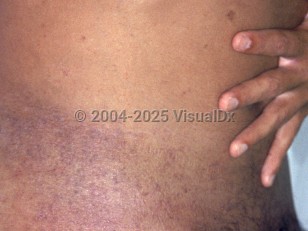Human T-cell lymphotropic virus type 1 (HTLV-1) is a retrovirus prevalent in Africa, China, Japan, South Asia, the Middle East, the Caribbean islands, and Central and South America. It has 2 major disease associations: adult T-cell leukemia / lymphoma (ATL) and HTLV-1-associated myelopathy (HAM), also known as tropical spastic paraparesis (TSP). This retrovirus is transmitted by blood transfusion, needle sharing, and breastfeeding. Additionally, it can be transferred by tissue donation and via sexual contact and occupational exposure in health care workers. Transmission can also occur from nonhuman primates in endemic regions of Africa.
HTLV-1 virus is associated with ATL, a proliferation of CD4+ T-cells that can present in various forms. The lifetime risk of developing ATL after infection with HTLV-1 is approximately 2%-5%, and development occurs about 20-30 years after initial infection. The acute form is seen in most cases and has an aggressive course (approximate 6-month survival) presenting with skin lesions, hypercalcemia, bone lesions, and pulmonary infiltrates. Central nervous system (CNS) involvement can also occur. The lymphomatous form presents with lymphadenopathy, hepatosplenomegaly, and skin lesions. The chronic form has a slightly longer prognosis (approximately 2-year survival) and presents without hypercalcemia, CNS involvement, or gastrointestinal involvement. The smoldering form is the least common and has the best prognosis (survival of approximately 5 years); it is limited to skin and lung involvement only.
HTLV-1 is also associated with HAM. It is characterized by slow-onset weakness and spasticity in the lower extremities, hyperreflexia, back pain, urinary frequency / incontinence, paresthesias, and sensory changes. The upper limbs are spared. HAM occurs more commonly in women, and its severity is related to the proviral load found in the CNS.
HTLV-1-associated infective dermatitis (HTLV-1-associated ID) is a chronic, relapsing skin eruption that occurs in children more frequently than adults in the Caribbean and South America (most frequently in northeastern Brazil). HTLV-1 is thought to drive the immune dysregulation that is responsible for the eruption, and secondary infection with Staphylococcus aureus or β-hemolytic streptococci is common.
Related topic: human T-cell lymphotropic virus type 2
Human T-cell lymphotropic virus type 1 in Child
Alerts and Notices
Important News & Links
Synopsis

Codes
ICD10CM:
B97.33 – Human T-cell lymphotrophic virus, type I [HTLV-I] as the cause of diseases classified elsewhere
SNOMEDCT:
429659006 – Human T-cell lymphotropic virus 1 infection
B97.33 – Human T-cell lymphotrophic virus, type I [HTLV-I] as the cause of diseases classified elsewhere
SNOMEDCT:
429659006 – Human T-cell lymphotropic virus 1 infection
Look For
Subscription Required
Diagnostic Pearls
Subscription Required
Differential Diagnosis & Pitfalls

To perform a comparison, select diagnoses from the classic differential
Subscription Required
Best Tests
Subscription Required
Management Pearls
Subscription Required
Therapy
Subscription Required
References
Subscription Required
Last Reviewed:05/21/2023
Last Updated:05/22/2023
Last Updated:05/22/2023

